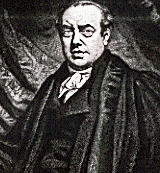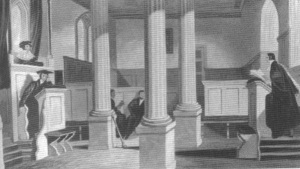 There’s not much time these days for researching and writing posts. But I do have little bites of time on the bus and Metro going to and from work, which lend themselves pretty nicely to article reading. I have also come back into possession of all the paper files I put into storage when I went to London, including a big stack of articles written by Simon Schaffer. Yes, folks, the Schaffer Oeuvre series has returned!
There’s not much time these days for researching and writing posts. But I do have little bites of time on the bus and Metro going to and from work, which lend themselves pretty nicely to article reading. I have also come back into possession of all the paper files I put into storage when I went to London, including a big stack of articles written by Simon Schaffer. Yes, folks, the Schaffer Oeuvre series has returned!
I was specifically inspired to bring the series back by Schaffer’s recent, very nicely crafted BBC documentary, “Mechanical Marvels: Clockwork Dreams,” (see a clip here), and by the realization that, when I left the series, I was just about to get to his articles on demonstration devices and automata. So, with no further ado, let’s dive right back in with “Machine Philosophy: Demonstration Devices in Georgian Mechanics,” Osiris 9 (1994): 157-182.*
“Machine Philosophy” is about the uses made of mathematician George Atwood’s (1745-1807) demonstration device (right) . The machine’s design employed a clock and counter-balanced weights hung from a low-friction pulley in order to clearly exhibit Newton’s first law of motion, and especially the quantitative predictions made by his second law, which interrelated force, mass, and acceleration. But the really difficult questions concerned what Atwood’s machine, and related machines, could and could not say concerning the intellectual status of Newton’s laws.
Schaffer’s related, more general concern in “Machine Philosophy” is with examining what sorts of epistemological work a demonstration device, such as Atwood’s machine, has historically been taken to be good for. He notes that Joseph Priestley (1733-1804), for instance, drew a stark contrast between demonstration devices and “philosophical” devices. According to Priestley, in his History and Present State of Electricity (1775) (158, but extended somewhat using the original text):
The instruction we are able to get from books is … soon exhausted; but philosophical instruments are an endless fund of knowledge. By philosophical instruments, however, I do not here mean the globes, the orrery, and others, which are only the means that ingenious men have hit upon to explain their own conceptions of things to others; and which, therefore, like books, have no uses more extensive than the view of human ingenuity; but such as the air pump, condensing engine, pyrometer, &c. (with which electrical machines are to be ranked) and which exhibit the operations of nature, that is of the God of nature himself, which are infinitely various.
The uses of a device were, then, deeply connected to the intellectual needs of a preconceived audience. As Jan Golinski argued in his Science as Public Culture: Chemistry and Enlightenment in Britain, 1760-1820 (1989), Priestley was deeply committed to the use of experiments to reason along with his audience so that they might ascertain the truth of philosophical propositions for themselves.
 Isaac Milner
Isaac Milner
On the other hand, Schaffer notes that, among Cambridge’s mathematical authorities, experimental demonstrations were not generally regarded as a crucial link in the establishment of philosophical truths. Atwood’s friend, Isaac Milner (1750-1820, senior wrangler “incomparibilis” in the 1774 tripos examination, and Lucasian Professor, 1798-1820) remarked in 1778, “Even when experiments are produced which seem to prove the point, one is apt to suspect the universality of the conclusion” (165).
At Cambridge, “demonstration” tended to connote an irrefutable logical demonstration, which, in turn, served the primary goal of the mathematical tripos: to instruct in the general practice of right reasoning. Looking back on his life at Cambridge in 1813, Milner recalled (163):
[W]e endeavoured not only to fix in the minds of young students the most important truths, but … particularly to be on their guard against the delusions of fanciful hypotheses in every species of philosophy…. A judicious prosecution of the science of mathematics and natural philosophy is among the very best preparatives to the study of theology in general and of Christianity in particular.
 Demonstration, 18th-century Cambridge style: a mathematical disputation. From Andrew Warwick, Masters of Theory: Cambridge and the Rise of Mathematical Physics (2003), p. 123.
Demonstration, 18th-century Cambridge style: a mathematical disputation. From Andrew Warwick, Masters of Theory: Cambridge and the Rise of Mathematical Physics (2003), p. 123.
Atwood regarded his machine as contributing to this project by inspiring students’ confidence in its foundations. He wrote in 1784 that coarsely designed instruments might well “assist the imagination” in understanding propositions that were already accepted, but that the goal of a demonstration device should be “to impress the mind with that satisfactory conviction, which always attends the observation of experiments accurately made” (167, my emphasis).
In other words, devices such as Atwood’s machine could aid students in accepting doctrines that were taken, by the conservative Cambridge establishment, to already be secure. The practice of indoctrination was, of course, anathema to radicals such as Priestley. But, for their part, the Cambridge authorities could point to a history of Newtonian principles accommodating a variety of observations, experiments, and philosophical challenges as a sound foundation for the doctrines that their students were now expected to accept, use, and build upon.
The universality of Newtonian principles was not, as noted in the quote from Milner above, considered by the Cambridge authorities to be provable through experiment. Rather, the presumption of universality necessarily rested on philosophy’s final connections to theology. As Cambridge tutor James Wood (1760-1839, senior wrangler 1782) put it in his 1796 book The Principles of Mechanics Designed for Students in the University, if one did not accept the fundamental truth of a divinely established cosmological order, “experiment could only furnish us with detached and isolated facts, wholly inapplicable on other occasions, and that harmony, which we cannot but observe and admire in the material world, would be lost” (168).**
In Pt. 2, we will look at Schaffer’s consideration of the uses of Atwood’s machine in debates over Newtonian principles beyond the confines of Cambridge.
Follow these links for paintings of Isaac Milner and James Wood. Also, via Thony Christie, some photographs of old Atwood machines.
—
*That year’s Osiris, by the way, was dedicated to the theme of “Instruments”. This was also, of course, the theme of the December 2011 Isis Focus section, to which Schaffer also contributed. Plus ça change, or something like that…
**Given what we know about the natural theology of the time, I think this point stands, but, if you actually go to the text you’ll find that Wood doesn’t mention anything about divine order in this passage.